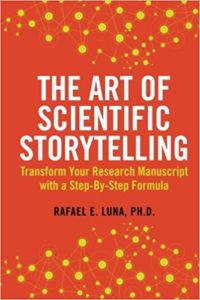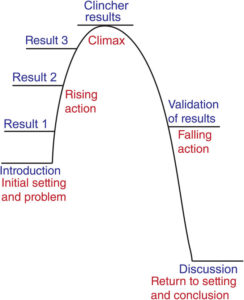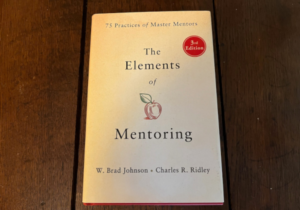Research Manuscripts Should Tell Really Good Stories
Book Review: The Art of Scientific Storytelling by Rafael E. Luna, PhD
Chapter 1: Introduction
Skim or skip. This section promotes the book and the promising ideas it conveys, when many of us (me, me, me) just want to get to the meat of the book. After several pages it reads as blah, blah, blah.
Key takeaways: The author, (who is Executive Director of the National Research Mentoring Network), has golden credentials and oodles of experience to share to help you write better.
Chapter 2: Fashioning Your Scientific Story Using the Basic Elements of Narrative Craft
Here’s the content I expected earlier. If you’re already familiar with narrative arcs, this section will feel familiar. If storytelling form is a new concept, then this can help identify the various narrative structures and prepare you to think creatively about how they apply to a research manuscript.
Figure 3 (at right with modifications) helps make the connection without needing to read the entire chapter. The Essential Toolkit of Storytelling Terms is basic, but does teach how to apply these terms directly to the scientific paper you are writing.
Key takeaways: Lifecycle of a Scientific Story begins with the Introduction, Results Section 1, Results Section 2, Results Section 3, Results Climax, Results Validation, and ends with the Discussion.
Chapter 3: An Order of Operations to Streamline Scientific Storytelling
A bit too wordy when telling stories within the larger story. I would prefer to cut to the chase and lay out the steps needed, which does happen by about the fourth page of the chapter, along with some solid general writing guidelines to consider in early drafts.
Key points are summarized in the following excerpt:
“The Introduction ushers your protagonist into a scene with a major problem/scientific unknown, which sets up your hypothesis. Results Sections 1, 2, and 3 show the protagonist undergoing increasing tension by step-wise experimentation to address the major problem/scientific unknown (overall hypothesis), which drives the reaction forward to its highest tension. The Climax experiment is the critical experiment that is centered on the protagonist and provides the strongest evidence for the major findings in the research study, which drives the reaction toward completion. The Validation step lends the most credibility of the study by making a step that makes your story believable. The Discussion section places your results in the context of the current literature, returning your protagonist to his original scene and showing how he is irrevocably changed.”
Key takeaways: The structure of research narrative mirrors other stories, and you can break it down by section. In fact, you should break it down by section and carefully include essential supporting details.
Chapter 4: Specifics for Writing Each Section (Here are the meat and potatoes!)
In the longest (and best) chapter of the book, we get section-by-section guidance on topics like selecting the best title, abstract essentials (sentence by sentence), storytelling through figures, results, introduction, discussion, and finally revision. These steps read a bit like recipes, and offer concrete and clear guidance about what to include.
The author notes:
“If you remember only two things from this book, it should be the following:
1.) A hypothesis can be defined as Conflict Resolution, which is the basis of all stories, especially Scientific Storytelling.
2.) Boldly state your testable hypothesis in your Title and throughout the text of your manuscript provide scientific evidence to substantiate your hypothesis (or in the urban vernacular: Drop the Mic!).”
Included at the end is a quick-start guide to hosting a Scientific Storytelling workshop of 6-18 participants along with critical analysis questions, which can be helpful even outside of the workshop setting and in solo editing.
Key takeaways: Use this section of the guide when crafting your first draft, then refer back to it throughout the revision process. If you mentor, consider if the Scientific Storytelling framework offers a fresh way to bring out more nuances of the flow of scientific writing.
 Additional Resources:
Additional Resources:
- Watch Dr. Luna discuss The Art of Scientific Storytelling in this 1 hour 20 min video.
- “Scientific Storytelling Helps Researchers Communicate Their Findings in a Competitive Publishing Environment,” a review of Dr. Luna’s seminar.
- Writing Well: Lowering the Barriers to Success, an article by James C. Gould, Rafael E. Luna and Donna L. Vogel.
- Available at Amazon.com for $19.95 (as of March 22, 2022).
- Available at AbeBooks.com for $15.89 (as of March 22, 2022).







1 Comment
The story structure listed is a good one, but there’s more than one structure that can be used – to some extent, it depends on your data, and your expected audience.